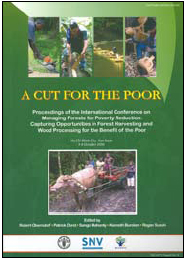 |
A Cut for the Poor. 2007. R. Oberndorf, P. Durst, S. Mahanty, K. Burslem & R. Suzuki, eds. Proceedings of the International Conference on Managing Forests for Poverty Reduction: Capturing Opportunities in Forest Harvesting and Wood Processing for the Benefit of the Poor. Ho Chi Minh City, Viet Nam, 3–6 October 2006. Bangkok, Thailand, FAO, Netherlands Development Organization (SNV) & Regional Community Forestry Training Center (RECOFTC).
Approximately one-third of the world’s forests are managed primarily for the production of wood and other forest products. Much of this production is carried out by commercial companies on a large scale. However, forestry production on a smaller scale (as this issue of Unasylva demonstrates) offers many opportunities for improving the livelihoods of the poor. Harvesting, transport, processing and marketing of forest products all offer opportunities for generating income in rural areas which can be enhanced through both institutional and technological means.
A cut for the poor is the proceedings of the International Conference on Managing Forests for Poverty Reduction: Capturing Opportunities in Forest Harvesting and Wood Processing for the Benefit of the Poor, held in Ho Chi Minh City, Viet Nam in October 2006. It reviews the potential of small-scale and labour-intensive forest management practices and wood processing to reduce poverty, identifying constraints, opportunities and ways forward.
The publication presents 19 papers grouped under the following themes: policies and legislation; economic issues; forest management modalities and institutional issues; technical aspects; and accessing markets. Individual papers address fundamental issues such as decentralization; simplifying requirements for community-based forest management; benefit sharing; increasing the value of forest products; managing risks; small-scale and community-based timber harvesting; and small-scale enterprise. Many focus on specific case studies, mostly from Asian countries (Bhutan, China, Lao People’s Democratic Republic, Nepal, Papua New Guinea, the Philippines, Viet Nam) but also from Cameroon and Ghana.
Also included are the conference declaration, opening statements and a summary of the conference.
This book will be of interest to anyone who wants to know more after having read the articles in this issue of Unasylva. To obtain a copy, contact: [email protected]
 |
Cross-sectoral policy developments in forestry. Y.C. Dubé & F. Schmithüsen, eds. 2007. Wallingford, UK, FAO & CABI. ISBN 978-92-5-105641-7.
As an essential resource for economic and social development, forests merit consideration in several policy domains. Forest protection and forestry practices are closely linked, for example, to public policies that address climate change, biodiversity, water management and agriculture. Public policy linkages across sectors are therefore essential not only for advancement of sustainable forest management, but for sustainable development in general.
Cross-sectoral policy developments in forestry has been prepared to improve awareness and understanding of potential positive and negative impacts of policies outside the forest sector on sustainable forest management, and to lead to more harmonized policies among forestry administrations and other sectoral agencies and stakeholders.
The publication compiles more than 20 papers presented at a technical session on cross-sectoral linkages in forestry, organized by FAO and the Swiss Federal Institute of Technology (ETH) at the twenty-second World Congress of the International Union of Forest Research Organizations (IUFRO) in Brisbane, Australia in 2005. These papers are rounded out by the addition of invited papers from a range of contributors. Together, the contributions provide a multifaceted documentation of current progress being made in creating the political, economic and social conditions indispensable for sustainable management and use of forest resources, and note the obstacles that need to be removed in order to reach this goal.
The first part of the book introduces general and global aspects that have to be considered in the context of cross-sectoral policy coordination – for example, the impact of external shocks such as a sudden oil price increase on forest management, the impact of energy or trade policies on global wood markets, and the influence of decentralization in integrating multiple demands on forests. It considers policy changes brought about through international agreements such as the Kyoto Protocol and the Convention to Combat Desertification; the common and divergent interests of agriculture and forestry in sustainable rural development; and the introduction of more comprehensive national accounting systems to link forest-sector decision-making and national development planning more effectively.
The second part deals with cross-sectoral policy linkages at the regional, national and local levels. The chapters on Africa focus largely on agroforestry, land tenure and gender issues, more integrated policies to promote reforestation and afforestation, and multiple-stakeholder planning processes. Highlighted with regard to Asia are environmental and economic accounts for forestry, non-wood forest product (NWFP) linkages, road construction and population effects on forest conversion, and contributions of community forest management to the local and national economy.
The chapters on Europe and the Americas emphasize patterns of competing policy demands between resource use, industrial expansion and strong environmental demands. Challenges noted in South America include environmental policy demands on forest management practices and transboundary watershed management systems.
Emerging from the overall picture is a need for improved policy planning and coordination across several political levels and economic sectors, as well as a call for regional and country networks with a view to creating and sharing information and knowledge on best practices.
This publication is an invaluable resource for policy-makers, landowners and representatives of non-governmental organizations. It will also aid students and researchers in forestry and the environment. It is hoped that the book will contribute to more integrated and effective development approaches at the country and local levels.
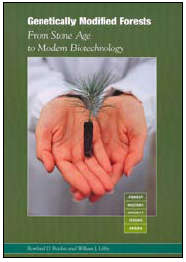 |
Genetically modified forests: from Stone Age to modern biotechnology. R.D. Burdon & W.J. Libby. 2006. Durham, North Carolina, USA, Forest History Society.
The term “biotechnology” came into common usage in the 1980s. While it is mainly used to refer specifically to genetic manipulation of plants and animals, in a broad sense – according to the authors of this short book – the concept covers anything that combines biology and technology.
Written by two authoritative forest scientists, Genetically modified forests is targeted at students, policy-makers, forest managers, forest landowners and environment advocates. The publication is easy to read and uses commonly understood terminology. Boxes and sidebars help clarify the text through examples and specific case studies. More specialized terms are bolded in the text when first used and explained simply in a brief glossary. The scientifically sound, clear and neutral treatment of complex and often controversial issues, lightened with splashes of humour, makes this book very enjoyable also for specialists and those with a scientific background.
As noted in the Foreword, “the story ranges from the time when humans were dependent upon hunting and gathering from the wilds to the sterile laboratory where particular genes are excised from one tree and surgically implanted into another”. The history of genetics and tree improvement is described in a series of brief, well-illustrated chapters on: historical efforts to improve trees; the science of tree breeding; conventional tree improvement; clonal forestry; the science of genetic engineering; and tree improvement at the start of the twenty-first century. While providing an excellent review of recent high-technology developments, the publication gives the reader an appreciation that there has been, and continues to be, more to forest genetics than just working on the molecular level.
During the past century, the use of conventional breeding techniques has allowed humans to improve the growth of forest trees on some lands to meet increasing human and environmental needs for wood and non-wood products while conserving forests on other lands managed for strict protection. Economic analyses have indicated that tree improvement offers greater return on investment than any other forest input. As pointed out by the authors, conservation of forest genetic resources must be considered an integral part of tree improvement programmes, ensuring their sustainability.
However, the domestication of forest trees has often met with public suspicion or professional scepticism, perhaps because many people perceive the aesthetic, recreational and spiritual values of the forest as incompatible with their value as a source of wood and non-wood products. More recently, real and imagined concerns of risks of genetic engineering have further inflamed the debate.
Thus some formidable challenges have arisen – not only technical (e.g. how to apply new advances in techniques of genetics, biochemistry, molecular biology and computer sciences to forestry) but also environmental, ethical and religious. As the authors note, social acceptance, both by the public and in a political context, is necessary if the potential benefits of biotechnology in forestry are to be realized. They stress that risk management to address concerns about genetic engineering and a trusted system of oversight and control will be essential to gain such acceptance.
The book closes by examining the question: Why should – or should not – biotechnology be applied to forests in the future? Whatever the controversies over the technology used, the authors note that two great, intertwined issues need to be solved:
The book concludes that biotechnologies (including genetic engineering), like any new technology, have their inherent risks and concerns. To the extent that the risks can be minimized, biotechnologies that can enhance the role of forest plantations and directly or indirectly help conserve natural environments are viable tools to address human needs.
To purchase, see: www.foresthistory.org
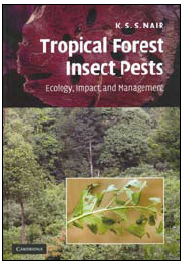 |
Tropical forest insect pests – ecology, impact, and management. K.S.S. Nair. 2007. Cambridge, UK, Cambridge University Press. ISBN 978-0-521-87332-1.
Much of the literature on forest entomology relates to insects of temperate forests. Tropical forest insect pests thus fills an important gap. It promotes a better theoretical understanding of pest population dynamics and causes of forest insect outbreaks in the tropics. It covers pests of both natural forests and plantations as well as stored timber, with recommendations for their control and management.
The book is organized in ten chapters. An overview of the features of tropical forests and their management is followed by an introduction to tropical forest insects, discussing their structural and functional diversity and the concept of pests. The third chapter discusses the ecological functions of insects in the forest ecosystem. The next three chapters describe pest incidence in natural forests, plantations and stored timber, respectively. Chapter 7 examines the circumstances under which insect populations increase and how they are regulated in nature. The following chapter addresses some general issues in forest entomology, such as pest incidence in plantations versus natural forests, in plantations of exotic versus indigenous species, and in monocultures versus mixed plantations. The ninth chapter examines pest management options.
The final chapter, which takes up almost half the book, comprises detailed pest profiles of the major tropical forest insect pests, including control options. This chapter provides a convenient and richly informative reference for practising foresters, planters and researchers who may seek information on particular tree or pest species. It would have been even more helpful, however, if the photos had been printed in colour. Although this would no doubt have raised the cost of the book, it would have enhanced its usefulness for diagnostic purposes.
This is a comprehensive resource suitable for advanced students and researchers in forestry and tropical forest entomology, and for forest plantation managers in the tropics. Its extensive reference list will enhance its usefulness in research. To stimulate further research, the author has included comments on knowledge gaps with each pest profile.
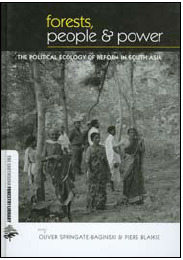 |
Forests, people and power: the political ecology of reform in South Asia. O. Springate-Baginski & P. Blaikie, eds. 2007. London, UK, Earthscan. ISBN 978-1-84407-347-4.
In recent decades, participatory approaches to forest governance and management have been introduced around the world. This book assesses their implementation in the highly politicized environments of India and Nepal. The authors critically examine the policy, implementation processes and causal factors that have impacts on livelihoods, demonstrating why policy reform often proves so difficult.
Specifically, Forests, people and power examines aspects of reform in forest management policy in three Indian states (West Bengal, Orissa and Andhra Pradesh) and two regions of Nepal (the mid-hills and the plains). Based on research and field practice spanning all levels, from households to key policy-makers, the book examines:
Data were collected from over 60 study villages and over 1 000 household interviews,
With tens of millions of hectares and hundreds of millions of lives in the balance, the debate over who should control South Asia’s forests is of great political significance. Delving into issues of power and politics in forestry, this book provides an insightful and thorough assessment of important forest management transitions currently under way. It explores the difficulties of transforming age-old structures that circumscribe the access of the poor to forests and their resources, and challenges assumptions of the benefits of participatory forest management and the role of forestry in poverty reduction.
These thoroughly researched, provocative studies will be of interest not only to those interested in community forestry in South Asia, but to others concerned with resource governance anywhere. It should be of interest to policy-makers and to all those who have been involved with the struggle of transforming forestry over the decades.
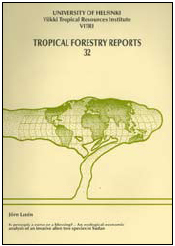 |
Is Prosopis a curse or a blessing? – An ecological-economic analysis of an invasive alien tree species in Sudan. J. Laxén. 2007. Tropical Forestry Reports No. 32. Helsinki, Finland, Viikki Tropical Resources Institute, University of Helsinki.
The intentional or unintentional introduction of Prosopis species that has occurred in many tropical and subtropical countries over a number of decades is a subject of controversy. While these introductions have frequently provided both environmental and economic benefits, in many situations Prosopis species have spread aggressively, to detrimental effect.
This publication, originally prepared as an academic dissertation, contributes new research to the international debate about the pros and cons of introduced Prosopis species. Focusing on the Sudan, the author investigated whether perceptions of net harmful impacts were true or false.
In the 1960s, foresters in the Sudan began to introduce the locally adapted Prosopis species as a shelterbelt tree in many densely populated rural areas. One of the aims was to ensure sufficiency of fuelwood and other wood products. In the following decades, Prosopis spp. were found to perform well in arid and semi-arid conditions; by the early 2000s they had been widely promoted and introduced in the country.
In the 1990s, however, problems became apparent because of the tendency of the popular Prosopis juliflora to invade farmlands and pastures, especially in and around irrigated agricultural lands, and it was labeled an alien invasive species. In 1995, a presidential decree for its eradication was issued. Much debate has ensued among foresters, researchers, land managers and politicians about the appropriateness of this policy.
The research described here measured the impacts of Prosopis juliflora on household livelihoods and income and its environmental, social and economic costs and benefits under different site conditions.
The main finding is that in many situations and for many parts of the population (mainly poor landless people), the social and economic benefits obtained from Prosopis spp. do or could exceed the costs involved in its control. However, the author points that most households do not fully realize the value of the Prosopis products from their land; for example, many buy fuelwood, charcoal and poles rather than producing, using or selling such products from Prosopis spp. on their land.
In other conditions, however, for example where Prosopis spp. grew in an agricultural scheme on clay soil, these plants were found to have more detrimental impacts on the costs of agricultural operations; in that case, their eradication from the scheme was initiated on the basis of the data collected for the study.
Concerning the environmental aspects, the author studied the losses (e.g. sealing of irrigation canals) and the gains (e.g. sand dune fixation, protection of arable lands and of infrastructures against sand encroachment). Biodiversity losses also have to be taken into account, and were perhaps less well addressed in this study.
This type of research, using site-specific, scientifically verifiable, realistically monetized values and taking into account local conditions (including soils), could be useful to evaluate the viability of Prosopis spp. in other situations in other countries. The author points out that such valuation approaches would need to be practically applicable – easy, fast and affordable for authorities and managers.